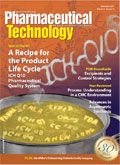The Challenges and Opportunities in ICH Q10
Jason Kamm, managing consultant with Tunnell Consulting discusses the challenges and opportunities for pharmaceutical manufacturers in ICH Q10, the draft guidance on pharmaceutical quality systems issued by the International Conference on Harmonization.
The International Conference on Harmonization (ICH) draft guidance IVJ Q10 Pharmaceutical Quality System, which was released for public input, is the latest harmonization effort as it relates to the pharmaceutical industry's move to a science and risk-based approach in pharmaceutical manufacturing.

Jason Kamm
Jason Kamm, managing consultant with Tunnell Consulting (King of Prussia, PA) discusses the challenges and opportunities for pharmaceutical manufacturers in implementing pharmaceutical quality systems and ICH Q10 with Pharmaceutical Technology 's senior editor Patricia Van Arnum.
Van Arnum: What would you identify as possible challenges and considerations for a pharmaceutical company trying to implement ICH Q10 as proposed or a pharmaceutical quality system in general?
Kamm: Despite some of the obvious benefits that these harmonized guidances offer pharmaceutical manufacturers, these initiatives have caught on slowly. We must remember that these guidances are all relatively new and that this industry has been notoriously slow to adopt these types of changes. The possible reasons for this are many. Because these are guidance documents as opposed to firm regulatory requirements, companies may feel little pressure to adopt them. Others may hesitate out of their traditional concern about unnecessarily exposing previously "hidden" process vulnerabilities. Some organizations may lack skills that are fully in tune with the requirements that these harmonized guidances involve.
The advantages, however, are attractive. These guidances offer a new paradigm that includes risk- and science-based approaches to current good manufacturing practices (CGMP) that aim to manage variability through improved process understanding as opposed to eliminating the variability. It also calls for identifying the areas of highest risk to the quality of the finished product and selectively applies high levels of controls and effort to those areas only. It requires a rethinking of how process development is done, integration of a new approach to validation, and a drive for continuous process improvement—all with the regulating agencies envisioned as a partner in improving processes.
Quality systems in general are difficult and complex mechanisms that present challenges to implement. Companies that are tasked with this effort typically have already been doing some activities that require at least the basic elements of a quality system. These may include GMP manufacturing, some formalized training, and some may have even had an inspection by a regulatory agency. The mistake some make is when they try to build a quality system "from scratch." This is often a problematic approach. The most successful approaches involve respecting and honoring the past by flow-charting the processes of the existing quality system. Only after this exercise is complete can a path be plotted for evolvement to a system such as ICH Q10 that is comprehensive and built upon the sound principles of the sciencee- and risk-based approaches.
There are many examples of the industry trying to better understand their processes, which is a terrific first step. There is still some hesitation related to how the regulating agencies will respond in practice. There is a great deal of faith involved with implementing these systems, but I would stress that the focus of the faith should not be on how regulating agencies will interact with these systems—the focus should be on the faith that these tools and this framework will provide the improvements and change we wish to see.
Van Arnum: What would you identify as the key components of ICH Q10 as a model for a pharmaceutical quality system?
Kamm: The main moving parts of a quality system include areas such as the handling of deviations, corrective and preventive action (CAPA), release systems, and process monitoring and controls. These components rely on two concepts that are a common theme throughout ICH Q10: continuous improvement and the management of change resulting from these improvements. ICH Q10 makes it clear that these elements apply not only to the product throughout its life cycle, but also to the quality system itself. In addition to these key components, ICH Q10 also nicely defines the product life cycle to include: product development, technology transfer, manufacturing, and product discontinuation. Continuous improvement involves elements such as cost savings, streamlining and elimination of waste. In addition, and perhaps more critically, continuous improvement allows for deeper process understanding throughout the product life cycle.
Reducing costs and improving efficiency in manufacturing is critical. Efficient processes go hand in hand with processes that are well understood. The focus on efficiency only occurs after processes are already stable, predictable and capable. The issues associated with the availability of a critical product (e.g., flu vaccine) can have an extreme effect on the public. If processes are better understood, and technology transfer could occur more smoothly, then shortage situations would occur less frequently. Products that have efficient manufacturing processes typically are not the products that we fear will run into problems related to market supply. In addition to these effects in manufacturing, reducing costs and speeding up product development can enable important drugs to make it to market faster. The end game of continuous improvement is to improve costs as well as to allow for faster innovation, deeper process understanding, and higher success rates of meeting the needs of the public.
Everybody wants to improve; nobody wants to change. This lies at the heart of all improvements because, after all, improvement is change. The management of this change is extremely important. The systems approach outlined in the quality system must ensure confidence that correct decisions are being made and encourage science and risk based approach to these quality decisions. They also promote process understanding, stressing the link between development and manufacturing, improving quality monitoring and review (based on data methods such as process control and process capability) and encouraging preventive action over corrective action.
The pharmaceutical industry in many ways has been lagging behind many other industries in their adoption of these continuous improvement activities. Having access to these approaches and having regulatory agencies in agreement on the rules of engagement is the important first step.
